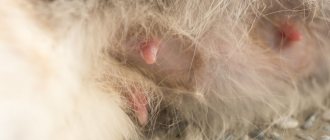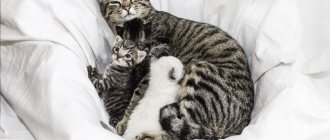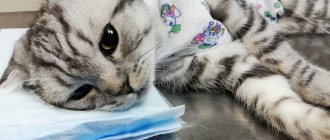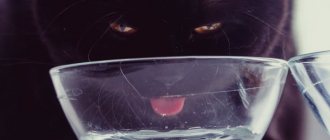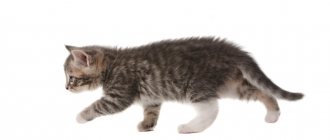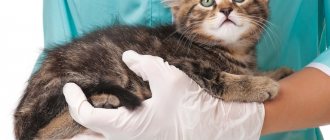If a young cat has appeared in your home, then today you need to think about how you plan to protect her from unwanted pregnancies. Many people think it’s too early to think about this, because in front of you is a playful kitten. In fact, time flies very quickly. Every owner should know at what age a cat can become pregnant, because forewarned is forearmed.
First things first
Of course, the numbers will be averaged, because each animal develops differently. The cat family is distinguished by its fertility and early maturity. The age at which a cat can become pregnant for the first time will be influenced by several factors:
- Breed.
- Genotype.
- Other features.
On average, a cat's first heat occurs at 6–8 months. It also marks the possibility of getting pregnant. Usually a young female is in no hurry to set off on an adventure. But the likelihood of having offspring will be higher if you also have a cat.
Caring for an animal in position
Pregnant pets require increased attention at all stages of their existence. They are kept away from danger, fed properly, their coat taken care of, and comfortable living conditions are created.
Animals in position are fed nourishingly and unobtrusively, with food balanced in terms of vitamin and mineral balance. You should not radically change your usual feeding routine - this can cause allergies and rejection in your pet. It is considered sufficient to add the necessary components, checking a professionally prepared diet. You can purchase specialized food for pregnant cats, but your pet should be switched to it gradually and carefully.
The animals are combed out carefully, with gentle, stroking movements. In the later stages, it is better to abandon this procedure altogether.
Bathing pregnant animals is allowed only in the early stages, up to 20-25 days of pregnancy. After crossing this line, they refuse to swim so that the stressful situation does not provoke a miscarriage and premature birth.
READ Symptoms and diagnosis of papillomas in cats Causes of papillomas in cats
In the later stages, 1-2 weeks before birth, it is recommended to limit the animal’s traumatic mobility, do not allow it to jump onto high window sills and shelves, or jump down from them.
Breed Features
The larger the pet, the longer it takes to develop. Therefore, Maine Coons and similar animals most often become sexually mature a little later. The first heat, and with it the opportunity to become a mother, usually occurs at 12–14 months. This also includes those with long coats. These are bobtails, Siberian and Norwegian cats. Shorthairs can mature before 6 months; in some, the first heat occurs at 4–5 months. This must be taken into account if you take home a young female. After all, without knowing at what age a cat can become pregnant, you can allow the birth of unwanted offspring.
Preparation and assistance during childbirth
By the first pregnancy, the cat should be normal, have the required weight (2.3–3.2 kg), and be in excellent physical shape. Only under these conditions will her body be able to easily endure the prenatal period and feeding the offspring. During pregnancy, it is necessary to closely monitor the health of the expectant mother.
It is very important to help your cat give birth for the first time. The first birth is quite painful, accompanied by severe pain. Young cats are nervous and scream loudly. Cats give birth for the first time within 2–6 hours. With weak labor, babies are born within 1–1.5 days. If labor is prolonged, it is better to carefully wrap the woman in labor and take her to the veterinarian. Doctors know exactly what needs to be done and how to help in this situation.
A new estrus occurs approximately one and a half to two months after lambing. The cat is ready to become pregnant again, but there is no need to speed up this process. Childbirth and feeding babies takes a lot of energy from the female, and the body uses up previously accumulated nutrients. If the breeder intends to get strong, healthy offspring, then the cat should not be forced to give birth frequently.
It is recommended for purebred individuals to have cubs no more than once every 1–1.5 years. Given comfortable conditions, the female gives 2.1 offspring per year. Researchers found that the interval between spring and summer lambing is 22.5 weeks, and between autumn and winter 28.8.
A cat can become pregnant up to six years of age. At older ages, females are capable of fertilization, but conception occurs much less frequently. Kittens often appear weak and non-viable. There is a high probability of genetic abnormalities and pathologies. A cat can give birth at an age that is considered already advanced (over 7–8 years). But the older the woman in labor becomes, the more problems and dangers are associated with bearing offspring. Therefore, experienced breeders try to stop reproduction in furry mature ladies.
Thus, the exact answer to the question - at what age do cats give birth depends on a number of factors
:
- animal body weight;
- genetics;
- living conditions;
- duration of photoperiod (length of daylight hours);
- breeds;
- nutrition;
- health status.
Already from approximately 6-8 months of age, most cats successfully become pregnant and give birth to healthy offspring. The owner’s task is to catch the right moment for mating or to prevent it.
The age at which a cat can become pregnant depends on both the breed and the individual. But the development of the embryos occurs practically by days and weeks, and after 60-68 days from the mating date the pet will be ready to give birth.
When the mating is planned, and the kittens are long-awaited, of course, you want to know for sure whether everything worked out. A cat can become pregnant only if the mating coincides with the period of readiness for ovulation and implantation of embryos. At different stages of cat pregnancy, doctors use different diagnostic methods.
Hormonal method
Cats are special in that they ovulate only after multiple matings during a short period of heat. In this case, the onset of pregnancy is determined using endocrine tests and blood tests:
- Immediately after mating, luteinizing hormone
, stimulating ovulation and maturation of the corpus luteum. Its presence in the blood helps determine that ovulation has occurred; - Progesterone, produced by the ovaries, begins to increase after ovulation and continues to increase until the 30th day of pregnancy. And then its level slowly decreases and drops very sharply just before childbirth. If progesterone levels rapidly decrease 1-2 weeks after mating, it means that the pregnancy was false and the cat may become pregnant in the next cycle. The test is valid from 40-45 days;
- Relaxin is another specific pregnancy hormone. In cats, it increases in serum from the 25th day of gestation. This method would be very reliable if all clinics performed such an analysis.
Lack of heat and physical changes
Absence, or simply “delay” for 45 days almost always indicates pregnancy. The cat does not “walk” and does not exhibit behavior characteristic of estrus. Although a cat’s first pregnancy can begin completely unnoticed even for her.
From about the fourth week of pregnancy (from the 21st day), you can notice an enlargement and redness of the nipples; by the 58th day they swell, and 5-7 days before birth they begin to produce colostrum.
With palpation, you can achieve 90% accuracy and even determine the number of kittens. Already on days 26-30, embryos can be felt as “balls”. From the 35th day they stretch and enlarge. An experienced surgeon will be able to determine the fact of pregnancy starting from day 28.
Changes in behavior are also a sign that will appear in the second half of the term: the cat becomes more careful, slower, eats more, and noticeably gains weight. Food preferences may change and signs of toxicosis may appear.
Instrumental methods
With the help of various devices, diagnosis is simplified, although not all methods are equally effective. For example, there is no point in trying to hear the fetal heartbeat in the early stages. But in the later stages, you can auscultate the kittens’ hearts through a stethoscope. Their heart rate is twice that of their mother.
On x-ray
from the middle of pregnancy there will be a noticeable enlargement of the uterus and displacement of the small intestine. But in the early stages of pregnancy, only soft tissue can be seen, which means pregnancy can be confused with diseases of the reproductive system. From day 40, the photo will already show the kittens’ ridges. From about the same time, ionizing radiation does not harm fruits.
Ultrasound
in B-mode confirms the presence of fertilized eggs in the early stages and is considered the safest method for the fetus and mother. The study is relevant from the 4-5th week after mating.
Everyone's responsibility
At first glance, reproduction is a natural phenomenon. Moreover, many believe that childbirth is necessary and important for the health of the animal. But look around. Today there are so many abandoned, unhappy kittens, cats and female cats who need a family that allowing new ones to be born is simply a crime.
Everyone hopes that good hands will be found for every kitten that their pet has. And usually they are found, especially if the litter is spring. Children are taken to the dacha during the summer holidays for children. What happens in the fall? They are abandoned in summer cottages, left at bus stops, or simply thrown into the yard.
Therefore, think very carefully before allowing your pet near the cat. If she is not purebred, then it is best to sterilize her. Some owners, in the old fashioned way, drown newborns and bury them in the garden. Despite the apparent inhumanity, this is better than starvation and painful death.
Pregnancy without estrus. Is it possible?
This cat brought a surprise to its owners. A surprise in the form of a belly and future kittens. And there would never have been a heat.
Cats are such mysterious creatures that they present surprises under the most incredible circumstances. According to logic and all the premises, this is impossible, but every rule has exceptions.
The cat does not allow the cat to come near her during periods of rest. In turn, this rule does not apply to cats. Cats experience a phenomenon called triggered ovulation .
Eggs suitable for fertilization are released only during estrus.
If the cat managed to mate with a “non-estrus” cat, then it is possible to stimulate the release of an “unplanned” egg, which can be fertilized. So we draw a conclusion. A cat is required for fertilization; you can do without estrus.
Features of physiology
Every owner should understand at least a little about these issues. Where his experience and knowledge are lacking, a veterinarian is needed. Today we’ll talk about the age at which a cat can become pregnant. From the moment of her first heat, she is physiologically ready to become a mother. This ability is sometimes retained until old age. There is no such thing as menopause in cats. That is, the reproductive age lasts from the first estrus until death. This must be communicated to the owners even before the furry beauty crosses the threshold of their home.
About sexual maturity of cats
The period of sexual maturity in these animals occurs at 7-9 months. This is the age of the first heat (estrus). From this time on, the female is capable of fertilization. The first heat is characterized not only by mucous discharge from the animal's loop, but also by a peculiar change in behavior - it is called sexual heat. The pet begins to scream invitingly, arching its back, rolling on the floor, inviting males. She refuses food and shows special tenderness to her owner if he is a man.
This behavior bothers not only him, but also his neighbors, because cats often scream at night. And if you don’t start using contraceptives in the first days of estrus, which lasts 10-14 days, then the cat can simply jump out the window and run away in search of a gentleman.
Breeders do not recommend allowing cats to become pregnant immediately during their first heat, because their bodies are not yet fully ready to produce offspring. Kittens may be born weak, inactive, and labor may be difficult. Experts recommend that owners wait until the second or third heat and then look for a partner for the cat, if pregnancy is planned at all. That is, the optimal age for a cat’s first pregnancy is 1.2-1.4 years.
Timing and stages of pregnancy
Gestation of kittens lasts from 58 to 78 days. It depends on the size of the animal and the breed. For example, Siamese cats bear offspring faster. After about three weeks, the nipples become enlarged, and it becomes possible to feel the babies in the tummy. At this time, the cat must be provided with adequate nutrition. It is best if it is special food for pregnant and lactating women.
When there are 1-2 days left before giving birth, the expectant mother becomes restless. She clings to her owner, looks for a secluded corner, meows. Now it’s best to equip her with a nest. A cat attached to its owner will want to give birth in his bed, and a very independent lady will try to leave the house for this. A cozy nest will help you avoid these extremes.
What determines the number of kittens?
The number of kittens in a litter is influenced by many factors:
- Firstly, this is the age of the cat. Firstborns most often give birth to a maximum of three cubs. Fertility also decreases in fairly mature females. After the age of seven, a cat gives birth to fewer babies than before the age of 6-7 years. The peak of large families (from 4 to 12 babies per litter) occurs between the ages of 3 and 6 years.
- Heredity also affects possible fertility. If the cat's ancestral ancestors produced numerous offspring, then most likely your animal will be fertile.
- The reason for the small number of kittens is often a hormonal imbalance, which leads to a decrease in the synthesis of eggs ready for fertilization.
- Breed also matters. A trend has been noticed: a purebred cat gives birth to fewer kittens than a mongrel yard animal, and rarely gives birth to more than 5 babies at a time.
- Obesity or, conversely, exhaustion reduces the possible number of offspring.
- A lot also depends on nutrition. If a cat does not get enough protein, taurine, vitamins and minerals, she may develop nutritional infertility (infertility). A meager diet leads to the fact that the animal’s defensive reaction to the lack of certain substances is the fertilization of a small number of eggs.
- Chronic inflammatory processes of the reproductive system negatively affect the cat's reproductive function and can cause the cat to become infertile.
- Another reason for the birth of a minimum number of kittens can be long-term and indiscriminate use of hormonal drugs, such as Counter-Sex, Sex-Barrier. Hormone-based contraceptives seriously undermine the reproductive function of the animal, causing hormonal stress in the body. And this, in turn, leads to the birth of a maximum of 1-2 babies in the litter.
The male also contributes to the number of offspring. During sexual intercourse, a temperamental cat releases a larger number of eggs for fertilization. In addition, the quality of sperm also matters.
Thus, the number of kittens in a litter is influenced by a variety of factors, and it is not always possible to take them into account.
When can you date a cat?
If you have firmly decided to have offspring and know well how you will look for a new home for your babies, then you need to first of all make sure that the expectant mother’s body is fully prepared for such stress. Knowing at what age a cat can become pregnant for the first time, you need to carefully protect her from accidental mating. After all, this is similar to how an 11-year-old girl who got her period for the first time would become pregnant and give birth to a child.
The owner's task is to maintain the health of the pet. This is what should be the priority. The onset of the first estrus only indicates physiological readiness to reproduce. But the owner must think about the other side of the issue. Both male and female cats should be examined by a veterinarian before mating. They are prescribed an examination for hidden infections, treatment for worms and other parasites, as well as vaccination.
Both breeders and veterinarians agree on the age at which a cat can become pregnant for the first time. To ensure that bearing offspring does not have a negative impact on the expectant mother, it is necessary to skip 2 or 3 heats, starting with the first. Pregnancy is a very energy-intensive event. Therefore, before the first conception, the female must be absolutely healthy and in excellent physical shape.
Here it is necessary to say once again that a caring owner should first of all think about the health of his pet. The myths that a cat needs to give birth constantly are unfounded. If your beauty is not the best representative of the breed, a winner of numerous exhibitions and a valuable carrier of the gene pool, then it is best to sterilize her upon reaching puberty.
Features of estrus in a cat
The reproductive cycle of a cat occurs in stages. It is quite difficult to see the onset of a certain phase without the appropriate knowledge. But every caring owner should be able to determine the time favorable for mating of an animal of a suitable age.
- Proestrus . The stage, which lasts approximately two days, is characterized by the body’s preparation for fertilization, which is expressed in an increase in estrogen synthesis. It can be recognized by the presence of clear discharge from the vulva, swelling of the genitals, hyperexcitability of the cat and loss of appetite. At the same time, the animal seeks the owner’s attention and attracts him by scratching pieces of furniture.
- Estrus . The stage during which a cat can become pregnant lasts about a week. But depending on individual characteristics, deviations of several days up or down are possible. Its onset in a cat of a certain age is marked by a sharp jump in the level of hormones in the blood. The cat begins to invite males with loud meows, squirming and shaking from emotional overexcitement, strives to get out of the house and cannot sit in one place. When stroked on the back, she bends down to the floor, raising her tail and lower back. Suffering from unsatisfied needs for procreation, she shows aggression and irritability. The standard frequency of estrus for a cat of a suitable age is once every three months, but some representatives may go through it much less frequently.
- Interestrus . If a cat of a certain age has been mated and becomes pregnant, she almost immediately loses interest in the male and begins to prepare for childbirth. Without sexual intercourse, the cycle moves into the final stage.
- Anestrus . The phase during which the cat's body rests can last a long time. He accumulates strength, preparing for the start of a new cycle.
© shutterstock
Even with the onset of heat at a certain age, a cat is unlikely to be able to become pregnant for the first time after one mating. Successful ovulation may require several contacts . This is due to the fact that the male, irritating the walls of the female’s vagina with his penis, stimulates the production of a special hormone. Under its influence, the corpus luteum is produced, which synthesizes progesterone, necessary for the productive implantation of embryos.
Sometimes a cat at an age suitable for pregnancy will be in heat with virtually no symptoms. The animal does not change behavior, does not react to males, and its body does not prepare for fertilization.
This indicates an extremely low concentration of sex hormones, but some pathology can block their production. Therefore, if the reproductive cycle is atypical, the cat must be shown to a veterinarian.
How long after it can be repeated
By about one and a half months, kittens become completely independent and are ready to move to a new home. It's time for owners to think about when a cat can get pregnant again. Usually just when she starts her next heat. But this does not mean that her body is ready for such a turn.
You can plan a pregnancy no earlier than in 5–6 months. And even if the previous lambing passed without complications, the animal must regain its strength. Bearing kittens, giving birth, feeding - all this is associated with a huge loss of nutrients and minerals. Mommy spends a lot of calcium, phosphorus and vitamins. All these substances go towards the development of fruits. Therefore, it is necessary to give her the opportunity to regain weight and normalize hormonal levels. This will take at least 3–4 months. It is believed that a cat should not have more than two litters per year. Otherwise, it wears out the mother’s body.
Can a nursing cat get pregnant?
A nursing cat can become pregnant within a week after giving birth
And don't doubt it, it can. Estrus resumes a month or two after birth. During this period, pregnancy is possible. There are cases when estrus occurs a week after the birth of kittens with known results and consequences.
Is it possible to sterilize an animal while feeding?
Undoubtedly .
It will not affect lactation, milk will not be lost. Some veterinarians recommend delaying sterilization, since a developed mammary gland provokes difficulties during surgery. Moreover, during feeding, the cat can already become pregnant again.
How often can a cat give birth?
This is another important question that veterinarians are also often asked. Now we know what time a cat can become pregnant, but we still need to understand how to be careful during the year. If her living conditions are good and her nutrition is adequate, estrus will occur with enviable regularity, and you will be faced with the problem of placing the offspring in good hands.
Of course, this frequency is typical for animals that have free access to the street. If there are cats living next door, then surprises cannot be avoided. In this case, it is extremely important to consider how many months a cat can become pregnant. After all, the offspring of a young female will most likely not be viable.
Even if your beauty is still nursing her babies, she may go into heat, and if there is a male nearby, she may become pregnant. This leads to exhaustion, weight loss, inflammatory diseases and other problems. As we said above, if the owner approaches breeding responsibly, then he must exclude such a possibility.
Is it possible to increase the number of kittens in a litter?
This question is usually of interest to breeders involved in breeding kittens for sale, since the expected profit depends on the number of offspring, as well as covering the financial resources spent on mating (treatment, testing, raising, feeding).
Depending on the regalia of the inseminating cat, the cost of mating can reach up to 10 thousand rubles. At the same time, owners of males are often not interested in the number of offspring. They receive money for mating, and the rest does not concern them. This position is fundamentally wrong: both parties should be interested in a good offspring. Before you give money for mating, ask:
- how often the cat is used;
- is he eating well? whether he has diseases of the genitourinary system;
- how many kittens are usually born from a male cat;
- Does the cat suffer from cryptorchidism?
To increase fertility, experts recommend injecting cats with the following drugs before breeding:
- Ovariovit: a homeopathic medicine that restores ovarian function, regulates the sexual cycle and increases fertility.
- Gamavit: anti-stress, immunostimulating drug, supports the vitality of the body, has a positive effect on eggs.
- Vitamin E: has a beneficial effect on the reproductive system, prevents infertility.
There is a special scheme designed for 10 days, which is often used for cats:
- Ovarium: 0.5 cc is administered subcutaneously once a day.
- Ortilin: 1 tablet twice a day.
- Ovariovit: 1 tablet 2 times a day.
- Vitamin E: 1 capsule twice a day.
- Gamavit: 1 cube per day subcutaneously.
- Catozal: 1 cube per day subcutaneously.
Treatment worsens signs of estrus and increases hormone levels. At the same time, the cat becomes more active and attractive to the inseminator.
Attention! Please consult your veterinarian before using this regimen for your cat.
You can also stimulate a cat by administering B vitamins to it for 2-3 days before mating, which have a positive effect on the activity and endurance of the male’s body.
The onset of old age
First heat is the age at which a cat can become pregnant for the first time. After this, throughout adult life, the owner needs to ensure that mating occurs no more than twice a year. If pregnancy is, in principle, not desirable, then it is best to coordinate the sterilization procedure with your veterinarian. They do it throughout their lives. True, there are also contraindications for health reasons.
In this regard, many are interested in when does a pet stop giving birth to kittens? Features of sexual behavior allow them to continue their race until old age. Therefore, you should not hope that after a certain number of years it will be possible to loosen control over the animal. In old age, they give birth to fewer kittens, but this does not fundamentally solve the problem.
The owner must approach this issue responsibly and not allow animals older than 7 years to be bred. When a cat reaches this age, it is easier to sterilize her so as not to create problems for herself and her. None of the professional nurseries will receive offspring from an animal that is 6–7 years old. Late childbirth will not add health to an elderly female, but her life is a fundamental value.
How kittens develop in utero
The development of fetuses and their maturity in the prenatal period is usually assessed in weeks, and in the earliest stages - in days. And many important processes occur in the first hours after mating:
- Mating stimulates ovulation in a cat. The brain produces luteinizing hormone, which triggers the release of eggs from the ovary. This process will take 36-48 hours and only one in a hundred sperm will reach the target;
- In the uterus, over the next 24 hours, sperm must meet eggs - this is fertilization. The genetic material of the mother and father are combined to form an embryo. Further, the cat’s pregnancy develops in strict accordance with the “schedule” conceived by nature.
First week (0-7 days)
The embryo grows and its cells divide. Blastocysts, freely moving throughout the uterus, attach to the uterine stacks approximately 7-10 days after mating. This process is called implantation and this is where the countdown begins.
Second-third week (8-21 days)
The placenta is formed. By day 15, it will fully provide protection and nutrition to the embryo. The embryo is still very small, but in its C-shape one can already discern the future head and tail. The fertilized egg can be palpated in the uterus. The cat becomes more capricious in its diet and spends a lot of time alone.
Fourth week (22-28 days)
The fertilized egg has a size of 15-20 mm. At this stage, it is quite difficult to distinguish a cat embryo from other mammals. But the formation of internal organs has already begun. First of all, the rudiments of the brain and heart develop.
On a sensitive ultrasound you can already hear this heart - 230 beats per minute! On day 28, the cat's paws begin to form: fur, pads and claws. The mother cat may feel nauseous. Outwardly, the pregnancy is not yet noticeable, but on an ultrasound you can already see something.
Fifth-sixth week (29-42 days)
Sense organs are formed. Nature pays special attention to the cat's hearing and sense of balance, and the skin prepares for development. The first, still soft, bones appear.
After day 38, the muscles and nervous system actively develop. The kitten begins to actively move inside the uterus. Some scientists suggest that already at this stage the psyche and character begin to form, and it is very important that the mother is in a good mood.
The length of the fruit is 4-6 cm. The female acquires a “pleasant roundness” and gains weight, becomes less mobile, and sleeps more.
Seventh-eighth week (43-56 days)
Bones, especially the spine, become visible on x-rays due to skeletal calcification. The fur is almost formed.
The embryo already resembles a kitten in all its outlines, but still has very short limbs and a tail. They will stretch out a little before birth.
At day 50, the kittens are generally ready for birth, but are still very vulnerable and will gain strength over the next 10-14 days. During this time, they will “work out” the reflexes of breathing, hiccups, sucking and everything that the baby will need in his future life.
Ninth week: preparing for childbirth
The mother begins preparations for the birth of her offspring. Her body signals the approach of labor with the first “test” contractions and the appearance of colostrum.
The cat looks for a place for a nest and settles in it. It is important at this time not to create stress for the expectant mother and to carefully monitor her diet and well-being.
Kittens at the end of the gestation period (60 days) are already 8-13 cm in length, about 100 g in weight and are ready for their new life. They will be born in the next 3-4 days.
This is a normal cat pregnancy week by week. For the next two months, the mother will warm, educate and teach her babies all the cat wisdom.
Interestingly, 1-3 weeks before giving birth, cats are ready for a new relationship. They can go on a spree and get pregnant immediately after giving birth. Therefore, free-living cats give birth throughout their lives, many 4-5 times a year. And at what age a mother can give birth to her last kitten is a matter of health and living conditions.
A cat becomes pregnant as a result of mating with a male cat. During mating, the cat undergoes stimulation of ovulation (the release of an egg from the ovaries) and fertilization. Ovulation and fertilization are possible only during the cat's estrus period.
As a rule, conception occurs 24-50 hours after mating. Days 3-5 of estrus are considered the most favorable for conception, but it is also possible on other days.
At what age can a cat become pregnant?
A cat can become pregnant as soon as it reaches puberty. Depending on the breed, this occurs at 6-18 months. However, early pregnancies (up to 1 year) can be extremely dangerous for the health of the cat and its offspring, so professional breeders do not breed cats until they are 12-14 months old.
Sexual activity in cats decreases after 6 years of age; cats continue to mate, but pregnancy, as a rule, does not occur. If, nevertheless, an “older” cat manages to become pregnant (and this is possible at 10-15 years), then it usually ends badly - miscarriages occur, kittens are born dead or with defects, the life and health of the cat itself are also at risk. Therefore, breeders spay and neuter cats at 6-7 years of age to prevent unwanted consequences.
How long does a cat's pregnancy last?
A normal cat pregnancy lasts just over 9 weeks (65 days). The duration of pregnancy can vary from 60 to 70 days.
Kittens born before day 60 are considered premature and usually die quickly. Extended pregnancy (more than 70 days) is a sign of pathology of the fetus or illness of the cat itself, so this is an obvious reason to consult a veterinarian.
The duration of pregnancy depends on the number of kittens (1-2 kittens are carried by a cat longer than 5-6), on the type of fur of the kitten (long-haired and semi-long-haired kittens are carried longer than short-haired and hairless kittens), and on the breed of the cat (Persians carry pregnancy the longest, least of all - Orientals, Siamese and other cats with light bones).
What drugs can be used
Above we have already touched upon the issue of contraception. Since birth control is necessary, it means that special medications are needed that can prevent mating. Moreover, given the age at which a cat can become pregnant, they should be used from a very young age. This issue is acute for owners of purebred animals during the rehabilitation period. Today there is a large selection of contraceptives for pets on the market. The following are especially popular: “Sex barrier”, “Stop-intim”, “Counter-sex”, “Gestrenol”, “Libidomin”.
When an animal is no longer able to give birth
People often wonder how old cats can give birth. Representatives of felines can reproduce until old age due to their sexual behavior. Older individuals produce much fewer kittens than young ones.
The owner must not allow mating of pets whose age is more than 7 years. Such a cat should be sent for sterilization. Experienced breeders and veterinary specialists think so. Bringing offspring at 6-7 years old is difficult for an old body. In addition, kittens may be born sick and weakened.
After sterilization, a cat recovers within 2-3 days

